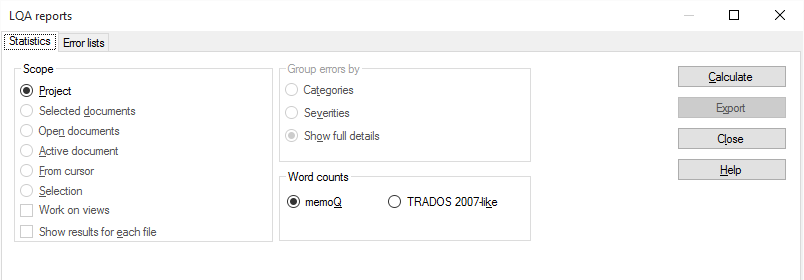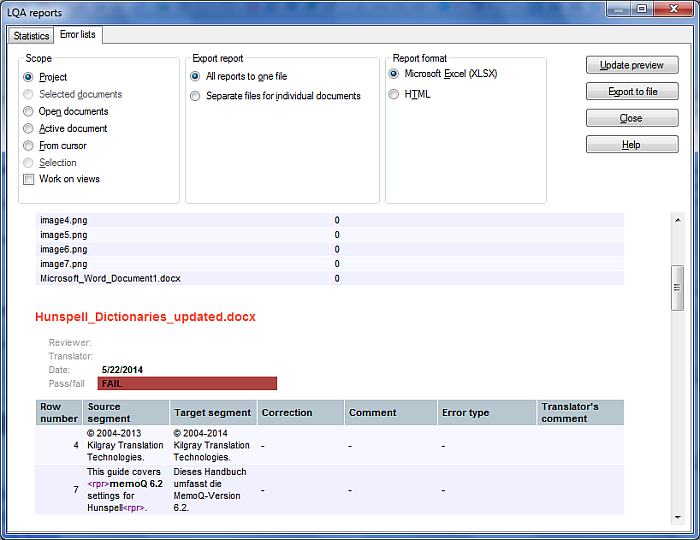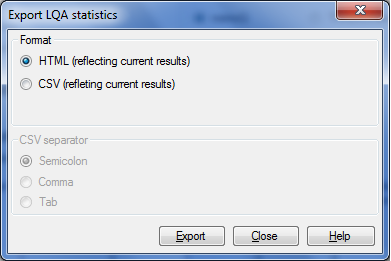|
You can generate an LQA report for your project or individual files. Furthermore, you can export a list of rejected segments. How to beginInvoke the LQA reports dialog by choosing LQA Reports in the Translations pane of Project home or on the Documents ribbon tab.
OptionsStatistics tabScope section: •Project: Select this radio button to analyse the whole project. •Selected documents: Select this radio button to analyse only the documents you selected in the Translations pane of Project home. •Open documents: Select this radio button to analyse only those documents that are currently open. •Active document: Select this radio button to analyse only the active document. •From cursor: Select this radio button to analyse only the active document downwards from the cursor. This option is only available if you start the dialog with a translation document open and active in memoQ. •Selection: Select this radio button to analyse only the selected segments of the active document. This option is only available if you start the dialog with a translation document open and active in memoQ. •Work on views: Select this checkbox to process the views too. •Show results for each file: Check this check box to get detailed information on every single file, not only aggregate information.
Group error by section: •Categories: Select this radio button to include all categories and subcategories of your LQA model, e.g.the category Language and its related subcategories Grammar, Punctuation, Spelling. •Severities: Select this radio button to include the severities of the errors which can be Minor, Major, Critical. •Show full details: Select this radio button to include the categories and severities in your LQA statistics. Error lists tab
The Scope section behaves similar as on the Statistics tab. The Export report section has 2 options: •All reports to one file: Click this radio button to generate one output file. •Separate files for individual documents: Click this radio button to generate separate reports for individual documents. The Report format section has 2 report export options: •Microsoft Excel (XLSX): Click this radio button to export your report in Excel format. •HTML: Click this radio button to export your report as HTML. Note: You cannot rename the the file(s). The error report lists for the selected documents: the memoQ user roles (Translator, Reviewer), the used LQA model and the pass Pass/fail status. The table contains the row number of the rejected segment, the source segment, the target segment, the correction, a comment (if entered), the error type and the translator comment (if it was passed back to the translator). In the target segment column, each rejected word, expression or marked text is highlighted in red. Below the detailed list for each document, you see a summary of the report. NavigationFor the Statistics tab: Click the Calculate button to analyze the texts with the specified settings and once the analysis is done, it shows the LQA statistics in the results pane. Depending on the number and size of resources, the calculation of statistics can take several minutes. Click the Export button to export the LQA statistics result where you can save the result into two common file formats, HTML or Comma-Separated Values (CSV) to load it into other applications like Microsoft® Excel® or send it to your client.
Click Close to leave the dialog.
For the Error lists tab: Click the Update preview button to update the preview of the report you are going to export. This comes in handy when you make further changes to the document, e.g. adding LQA errors, i.e. more segments get rejected. Click the Export to file to export your report. When you export to Excel, and use the individual documents option, then a worksheet is generated for each document, having the name of the document. The last worksheet contains the report summary. Click Close to leave the dialog. |


